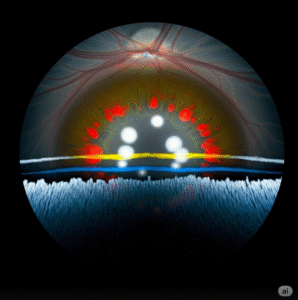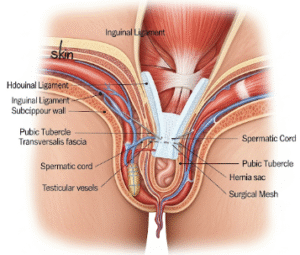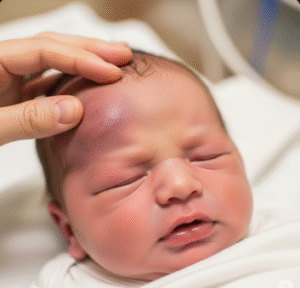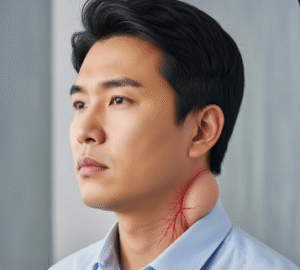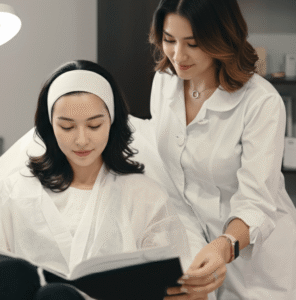Gentle dermatologic care for common infant scalp conditions
What it is
Cradle cap, medically known as infant seborrheic dermatitis, is a common skin condition in newborns and infants. It appears as yellowish, greasy, scaly patches on the scalp, though it may also extend to the face, ears, or diaper area.
Unlike eczema, cradle cap is not itchy or painful. It is thought to be caused by a combination of factors, including:
- Overactive sebaceous (oil) glands influenced by maternal hormones.
- Natural yeast (Malassezia) overgrowth on the scalp.
- Immature skin barrier function.
Cradle cap is harmless and self-limiting, often resolving within the first year of life. However, dermatology clinics in Korea provide education, gentle therapies, and cosmetic care to help parents manage symptoms safely and effectively.
Why it’s done
Managing cradle cap is important for several reasons:
✔ Cosmetic improvement – Parents often seek care for visible flaky or crusty scalp.
✔ Comfort and hygiene – Thick scaling can trap sweat and oil, making the scalp harder to clean.
✔ Prevention of complications – Severe cradle cap may become secondarily infected or spread to other areas.
✔ Parental reassurance – Counseling ensures families understand the harmless nature of the condition.
✔ Support for sensitive skin – Many infants with cradle cap also develop eczema or other skin sensitivities later, so early education helps.
Alternatives
Cradle cap is usually mild, and several alternatives to medical treatment exist.
→ Observation – Many cases resolve spontaneously without treatment.
→ Gentle cleansing – Washing the scalp daily with mild baby shampoo.
→ Emollient application – Oils (mineral oil, baby oil, or coconut oil) soften the scales for easier removal.
→ Over-the-counter antifungal shampoos – For more stubborn cases.
→ Medical treatment – Topical antifungal or mild corticosteroid creams if inflammation or spreading occurs.
In Korea, clinics emphasize minimal medication use, preferring gentle methods and parent education.
Preparation
Parents should be prepared before seeking care for cradle cap.
➤ Medical evaluation – To confirm cradle cap and rule out eczema, psoriasis, or fungal infections.
➤ Family history – Including allergies or skin sensitivities.
➤ At-home observation – Parents should note when scales first appeared and whether the rash spreads.
➤ Product review – Doctors check current shampoos, oils, or creams being used.
➤ Parental counseling – Families are advised about safe scalp care and the benign nature of the condition.
How it’s done
Management of cradle cap focuses on gentle removal of scales and prevention of recurrence.
➔ At-home care guidance –
- Apply baby oil or mineral oil to the scalp for 15–30 minutes.
- Gently brush with a soft baby brush to loosen scales.
- Wash with a mild shampoo afterward.
➔ Medical treatment (if needed) –
- Antifungal shampoos (such as ketoconazole) for resistant cases.
- Mild corticosteroid creams for inflamed or spreading lesions.
- Topical calcineurin inhibitors in select cases for sensitive areas.
➔ Clinic-based therapies in Korea –
- Korean pediatric dermatology clinics may provide scalp hydration treatments and gentle exfoliation.
- Additional cosmetic care such as skin-soothing light therapy may be used in stubborn cases.
Recovery
Recovery from cradle cap is typically straightforward.
→ Most infants improve within weeks to months with regular gentle care.
→ Scales may return occasionally but usually resolve by age 1.
→ Parents see cosmetic improvement quickly after consistent cleansing and moisturizing.
→ Long-term effects are rare, though some infants may later develop mild eczema.
Complications
Cradle cap is usually harmless, but complications may occur if improperly treated.
✔ Skin infection – From scratching or harsh removal of scales.
✔ Persistent redness – May indicate another skin condition like eczema.
✔ Pigmentation changes – Temporary light or dark patches after healing.
✔ Parental stress – Worry about appearance or mistaken concerns about hygiene.
In Korea, clinics minimize risks by teaching safe home care and offering gentle interventions if needed.
Treatment options in Korea
Korea offers world-class dermatology care with emphasis on safe, gentle infant therapies.
➤ Pediatric dermatology clinics – Provide expert diagnosis and parent-friendly guidance.
➤ Gentle care protocols – Focus on oils, mild shampoos, and soft exfoliation, minimizing drug use.
➤ Advanced treatments for stubborn cases – Use of antifungal shampoos, mild corticosteroids, or calcineurin inhibitors under close supervision.
➤ Integration with skin care education – Parents learn scalp hygiene, moisturizer use, and flare-up prevention strategies.
➤ Cosmetic dermatology support – Some clinics offer hydration facials, light therapy, and scar-prevention routines if cradle cap spreads or leaves irritation.
➤ Medical tourism readiness – Clinics in Seoul and Busan provide bilingual counseling, structured treatment programs, and supportive care for international families.
➤ Research and innovation – Korean dermatologists actively study safe infant skincare protocols, ensuring treatments are evidence-based.
By seeking cradle cap care in Korea, families benefit from gentle, effective, and cosmetically aware treatments, ensuring both the infant’s comfort and the parents’ peace of mind.


